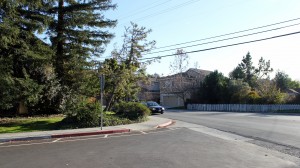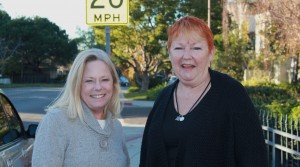[youtube]g9pE-PZfyDQ[/youtube]
Roughly 5,000 drivers a day in Redwood City use Valota Street as a convenient way to cut from Woodside Road to Jefferson Avenue. This one-mile stretch of roadway has a traffic lane in each direction and a speed limit that changes midway from 25 to 30 mph. While it has long been a busy street, many Valota residents believe conditions have grown unsafe in recent years. So when a developer applied to build a five-house subdivision on Valota, two neighbors saw it as an opportunity to call for a change.
Lori Burnett and Barbara Stacy live on Doris Court, a cul-de-sac that intersects with Valota just before a curve in the road. Their garages back out to Silver Street, where making a left turn onto Valota means navigating a blind corner. Without a stop sign between Woodside Road and Redwood Avenue, they said, too many drivers fail to slow to 20 mph for the curve.

“The thing is that nobody slows down,” Stacy said.
On Jan. 13 — nearly two years after Burnett and Stacy launched into action — the Redwood City Council is scheduled to vote to install a stop sign at the intersection of Valota and Silver. For the two neighbors, an affirmative council vote will be proof that, with a lot of persistence, the voices of citizens can be heard. “It gave me some faith in our city government,” Burnett said after learning this month that the stop sign was on the council’s agenda.
Their apparent victory, though, was anything but easy.
It all began in February of 2012. That’s when the city announced a public hearing on the proposed construction of five single-family homes at 1410 Valota, prompting Burnett and Stacy to organize neighborhood opposition. They circulated a petition, which stated that traffic on Valota makes it “dangerous and time consuming” for residents to exit their driveways and that the addition of five houses “will not only increase the traffic on Valota, but increase the risk of accidents as cars continue to speed around the curve.”
If the project were to be approved, the petition continued, the city should install “traffic calming devices” — speed bumps, flashing lights or stop signs — as mitigation.
The city’s environmental review concluded that the development would not have a significant impact on traffic. At an April 3, 2012 Planning Commission meeting, Michelle Littlefield, an associate planner, explained that this meant “there would be no nexus for the city to require the developer to include or pay for the requested improvements.”
Disappointed but undeterred, Stacy and her husband then met with city staff to discuss possible traffic calming solutions. But Valota Street’s status as a primary emergency response route made the issue more complex. Jessica Manzi, Redwood City’s senior transportation coordinator, said her staff needed to work with the fire department to ensure changes to the road would not “adversely impact their response times.”
A year went by without any construction work on the houses or safety measures added to the road. When the developer returned to the Planning Commission in July 2013 to renew the project’s planned development permit, Stacy, Burnett and some of their neighbors attended the meeting to reiterate their concerns. The commission again approved the permit.
“There’s nothing really we can do except show our concerns as neighbors,” Burnett said at the time. “We took pictures and presented them to the [commission], but still didn’t feel it was getting through.”

In October, the City Council met to consider an appeal of the commission’s decision. Though the council denied the appeal, it was at this meeting that Burnett began to feel optimistic for the first time.
“The neighbors’ concerns are valid because [they] live there,” said then-Mayor Alicia Aguirre, who remains on the council. Calling it “a quality of life issue,” Aguirre urged the city to consider measures to slow the traffic on Valota.
Putting a stop sign at Valota and Silver, where the road curves, was deemed to be the best way to ensure that drivers “clearly understand who has the right of way and can see the other cars that are potentially turning through that intersection,” said Manzi, the senior transportation coordinator.
If approved by the council on Jan. 13, the stop sign could be installed by the end of January.
It can’t come soon enough for Andrew Weiss, who lives just past the intersection. In 2010, an intoxicated driver hit a parked car with enough force to push it into his front lawn.
“My house has probably had the worst because of the curve,” he said.
Burnett and Stacy plan to attend next month’s council meeting, of course, prepared to celebrate “a victory for our neighborhood.”
